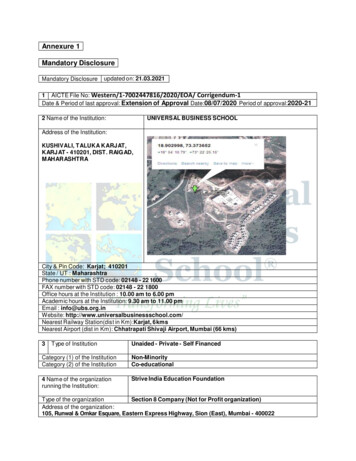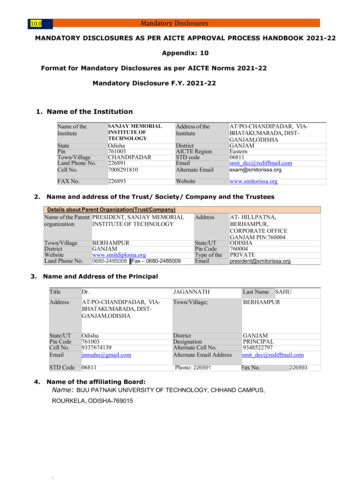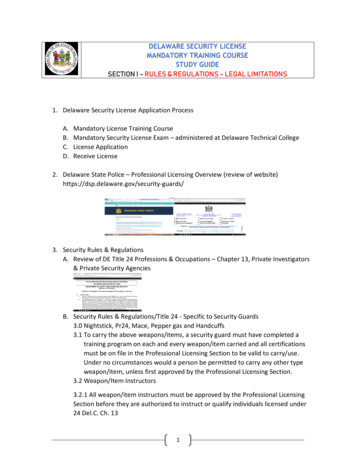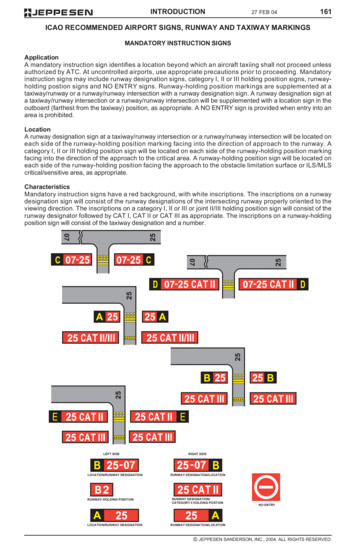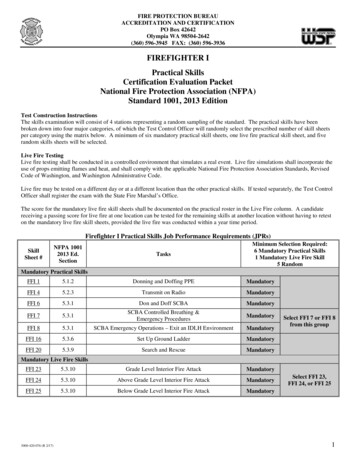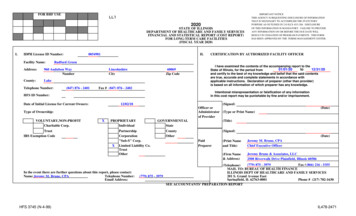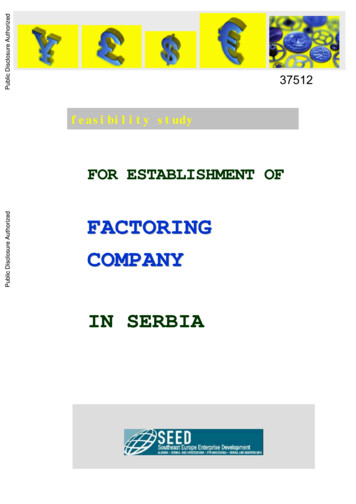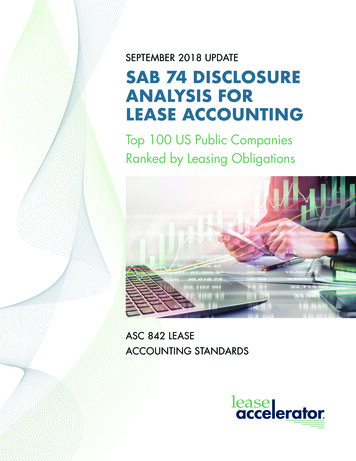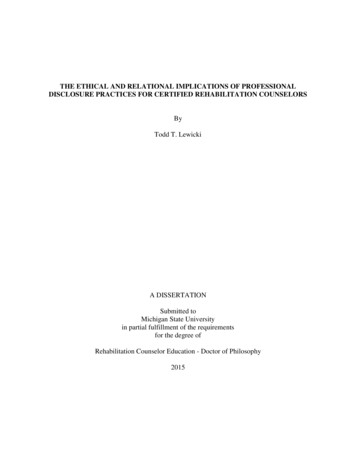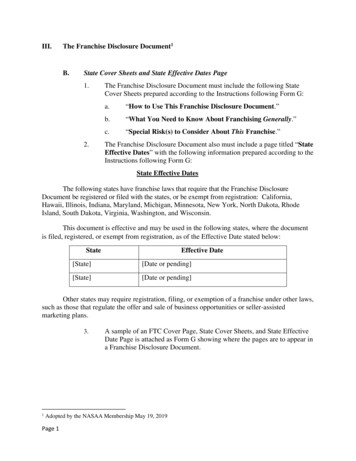
Transcription
Mandatory Disclosures forFederal Government Contractors:What, How, and When?Kara M. SacilottoKevin B. MuhlendorfSeptember 25, 2018This presentation is accompanied by oral explanation and should not be relied upon for legal advice.Copyright 2018 Wiley Rein LLP
Overview§§§§§Statistics of InterestDisclosure ObligationsWhistleblower WorldDOJ Policy ChangesTips to Mitigate Risks2
Statistics§ DOD IG Over 5,700 contacts to the DOD Hotline from Oct. 1, 2017-Mar. 31, 2018–Most related to personnel misconduct, personnel-related matters, reprisal complaints, andimproper procurement or contract administration matters 940 whistleblower reprisal complaints to DOD IG or Component IG–84 concerned defense contractor reprisal 113 contractor disclosures, as required by FAR 52.203-13––Largest percentage of disclosures related to labor mischarging (68%)Fewer than half the reports than from one year ago (274 in Oct. 2016-Mar. 31, 2017)§ GSA IG 5 contractor disclosures received Oct. 1, 2017-Mar. 31, 2018–Also less than year ago (7 for period Oct. 2016-Mar. 31, 2017) Concluded evaluation of 8 disclosures, recovering over 1.4 million (M)3
Statistics§ Dec. 21, 2017: Department of Justice (DOJ) reports FalseClaims Act recoveries for Fiscal Year (FY) 2017 3.7 billion (B) (one billion less than FY2016)– 2.4B from health care industry, including drug companies, medical devicecompanies, hospitals, nursing homes, labs, and physicians– 543M from financial industry re housing and mortgage fraud– Procurement fraud recoveries ran the gamut:§ 95M (plus foregoing 249M in claims) to resolve allegations of overcharging for local produceprovided to soldiers in Iraq/Kuwait§ 125M to resolve allegations that charged DOE for deficient nuclear quality materials§ 45M to resolve allegations that made false statements and claims to GSA in negotiation ofsoftware licenses§ 29.5M to resolve ARRA overcharging allegations§ 16M to resolve allegations involving small business program eligibility4
Statistics§ DOJ (cont’d) Whistleblowers filed 669 qui tam suits in FY2017 – “an average of more than 12 newcases every week”–Of the 3.7B recovered, 3.4B related to qui tam suits–DOJ paid out 392M to whistleblowers§ ISDC§ Even though FCA recoveries overall declined, qui tam suit recoveries increased ( 3.4B in FY2017 vs. 2.9B in FY2016) Agency suspensions and debarments decreased 14% in FY2017 over FY2016 (604suspensions, 1613 proposed debarments, and 1423 debarments in FY2017)–Even decreased numbers represent nearly double the activity reported in FY2009, when the ISDCbegan tracking this data Proactive outreaches by contractors before a debarring official raises concerns alsodecreased from 76 to 53 between FY2016 and FY2017 Pre-notice letters (e.g., show cause) increased 21%5
FAR Mandatory Disclosure§ FAR 52.203-13, Contractor Code of Business Ethics andConduct– Business ethics awareness and compliance program, generally tracksFederal Sentencing Guidelines requirements for effective compliance andethics program– Internal control system that allows the company to timely discoverimproper conduct Mandatory Disclosure Requirements in FAR 52.203-13:– Must “timely” disclose “credible evidence” of certain procurementrelated federal criminal violations and violations of civil False Claims Actto Agency Office of Inspector General (OIG)6
FAR Mandatory Disclosure§ Mandatory Disclosure Requirements in FAR 52.203-13(cont’d): Applies to all covered contracts ( 5.5M and 120 days), and must beflowed down to covered subcontractors– Although small businesses and commercial item contracts exempt from52.203-13(c) compliance program and internal controls requirements, not exemptfrommandatory disclosure obligations. See FAR 52.203-13(b) Noncompliance with disclosure obligation is ground for suspension/debarment under FAR 9.4 (knowing failure of “principal” to “timely”disclose “credible evidence” of enumerated procurement-related andsignificant overpayments)7
How Do You Know What To Disclose?§ Guiding Principles: Policy and practice must encourage reporting. If you seesomething, say something The goal is to be proactive, not reactive How would you explain to a neutral third party a decisionNOT to disclose? Bad news does not get better with age The “cover-up” is worse than the crime8
FAR Mandatory Disclosure: Managing theInvestigation§ Overview of structure of corporate/internal investigations at BAE Systems Chain of command§ Initiation of investigation: the intake process§ Who investigates?§ How are investigations tracked? “Timely” not defined in rule or preamble (73 Fed. Reg. 67064 (Nov. 12, 2008)) Rule contemplates sufficient time to conduct investigation to determine whether“credible evidence” exists “Reasonable steps that the contractor considers sufficient to determine that theevidence is credible”9
FAR Mandatory Disclosure: Managing theInvestigation§ Use of templates, scripts§ How to handle employees who are reluctant to talk tointernal/external investigators or who might be involvedin wrongdoing?§ How are investigations findings and results documented?§ When to hire outside counsel§ When to hire other outside professionals (computerforensics, accountants)10
FAR Mandatory Disclosure: Managing theDisclosure§ What is the process for determining whether a disclosure is required? Internal coordination of decision-making Obligation rests with the “principals” of the company. What is a “principal”? Net iscast both broadly and ambiguously–“Officer, director, owner, partner, or a person having primary management or supervisoryresponsibilities within a business entity (e.g., general manager; plant manager; head of a division orbusiness segment; and similar positions)§ Drafting the disclosure Use and views on “batch” disclosuresStandard letter format?Remedial measures in disclosures?Discipline discussed in disclosures?11
FAR Mandatory Disclosure Insights§ Disclosures to DOD IG are sent to DOJ and AgencySDO as matter of course DCIS and DCAA may also become involved DOD IG practice to promptly send letter that their office is“coordinating with the Department of Justice and Defenseagencies with equities or interest in the disclosure” Routine to route disclosures to civil/criminal DOJ Does not necessarily mean a DOJ judgment has been made12
FAR Mandatory Disclosure Insights§ All mandatory disclosures are reviewed in the CriminalDivision by the Fraud Section in Washington§ Very few disclosures result in cases being opened by criminalprosecutors. Many more are acted on by DOJ Civil§ Vast majority of disclosures are time charging violations, manyvery minor. Vast majority of them indicate discipline hadbeen handed out§ Cases that are further criminally investigated are brought toDOJ attention by OIG or picked up from a qui tam, not onbasis of mandatory disclosures13
FAR Mandatory Disclosure Insights§ Characteristics of a criminal case: Loss (greater flexibility when conduct threatens agovernment mission) Pervasiveness of misconduct Clarity of contractual or regulatory “ground rules” Presence or absence of certifications Internal communications (emails, recorded calls, etc.) Evidence of concealment14
FAR Mandatory Disclosure Insights§ DOD IG requires information on individuals involved indisclosed conduct Often leads to inquiry from SDO regarding present responsibilityof individuals May affect security clearance§ Discipline is two-edged sword Discipline expected by some regulators; others may not think it isenough (i.e., scapegoat or larger organizational issue?)15
FAR Mandatory Disclosure Insights§ Remedial measures? If you make a disclosure, behooves you to address consideration/remediation– Prevent retention of an overpayment– Address the matter “timely”– Get ahead of the SDO§ Close Out Notice?: DOD IG and GSA IG state that theygenerally provide written notice to contractor if agencydecides to close a disclosure16
FAR Mandatory Disclosure Insights§ Regulator position: no de minimis amount Some regulators bemoan the quantity of disclosures vs. quality ofdisclosures Some regulators question whether “all” misconduct reported§ Your idea of “credible evidence” may not be the same as theregulator’s view Overly legalistic analysis? How will you explain the failure/absence of a disclosure to a regulator?§ Subcontractor disclosures Upstream FCA implications for prime Advance notice to the subcontractor?17
Other Sources of Disclosure Obligations§ Grants, 2 C.F.R. 200.113 Requires organization to disclose “in a timely manner” to the awardingagency or pass-through entity “all violations of federal criminal law involvingfraud, bribery, or gratuity violations potentially affecting the federal award”§ DFARS rule promoting “voluntary post-award disclosure ofdefective pricing,” finalized May 4, 2018, DFARS 215.407-1(c)(i) Relates to findings of defective pricing when contractor provided certifiedcost or pricing data To promote voluntary contractor disclosures of defective pricing, gives DODcontracting officers discretion to discuss disclosure with DCAA and, asnecessary, request a limited-scope or full-scope audit Disclosure to CO18
Other Sources of Disclosure Obligations§ Overpayments, FAR 52.232-25(d) If Contractor becomes aware of a duplicate contract financing/invoice payment or that Governmenthas otherwise overpaid, Contractor must remit overpayment witha description of the circumstancesof the overpayment, affected contract/deliver order and lineitems along with supporting documents Disclosure to CO§ Reps and Certs in SAM and FAPIIS, e.g., FAR 52.209-5and 52.209-7 (Responsibility Matters)19
Other Sources of Disclosure Obligations§ Anti-Kickback Act, 41 U.S.C. §§ 8701-8707, implemented in FAR 3.502,Subcontractor Kickbacks, and FAR 52.203-7 Disclosure obligations similar, but not identical, to mandatory disclosure. See 41U.S.C. § 8703; FAR 3.502-2(g) and FAR 52.203-7(c) (2)–“reasonable grounds to believe” standard Criminal, civil, and administrative penalties§ Combating Trafficking in Persons, FAR Subpart 22.17 and FAR 52.222-50 FAR 52.222-50(d) requires contractor to: (1) “notify” CO and Agency OIG of anycredible information that a contractor employee, subcontractor employee or agenthas engaged in conduct that violates 52.222-50(b) (policy and list of prohibitedconduct); and (2) any actions taken against a contractor employee, subcontractoremployee or agent pursuant to clause20
Other Sources of Disclosure Obligations§ SEC Disclosure Obligations Do you have to disclose allegation of fraud, a CID, or an SEC subpoena?– It depends, but generally no automatic duty to disclose§ Richman v. Goldman Sachs Group, Inc., 868 F. Supp. 2d 261 (S.D.N.Y. 2012) (no duty to disclosereceipt of SEC Wells notice) Have to disclose if there is a Rule, such as “material” legal proceedings inSEC Regulation S-K, Rule 103 Have to disclose if failing to do so would render another disclosuremisleading Investigation could reveal internal control failings requiring disclosure21
Disclosures in a Whistleblower World§ SEC Whistleblower Program Over 4,400 whistleblower tips in FY2017– Number of tips has increased every year since FY2011– 50% more than first year with full program data (FY2012) In FY2017, Corporate Disclosures and Financials accounted for highestpercentage (19%) of complaint type; Offering Fraud was second mostcommon complaint (18%); Manipulation was third (12%) In FY2017, SEC awarded 50M to 12 individual whistleblowers– Three of the ten largest awards were in FY2017– 322M awarded to 58 whistleblowers since program inception22
DOJ Corporate Enforcement Policy§ Corporate criminal liability is resolved through either indictment, guilty plea,deferred prosecution agreement, non-prosecution agreement, or declination§ Outcome depends on “Filip Factors” listed in USAM 9-28.300 Nature and seriousness of offense Pervasiveness of wrongdoing andmanagerial involvement History of misconduct Cooperation Existence of effective complianceprogram Timely and voluntary disclosure Remedial actions Collateral consequences to public andshareholders Adequacy of other remedies, such ascivil enforcement or debarment Adequacy of prosecution of individuals23
Factor Four: Cooperation§ Cooperation is connected to the adequacy of criminal prosecution (“YatesMemo”)§ Cooperation generally involves: Revealing results of internal investigation (without waiver of privilege) Review and disclosure of emails; documents; and audio files (litigation holds areessential) Making current employees available for interview Coordination of interviews with DOJ (tip: adverse employment actions and publicfilings may impact investigation) Assessment of loss Cooperation in court processes§ Continued cooperation through DPA or NPA agreements24
Factors Five and Seven: Compliance Policies§§Fraud Section Guidance on “Evaluation of Corporate Compliance Programs” (available online) issuedin February 2017Includes 11 key compliance metrics and a set of “common questions” that DOJ considers inassessing compliance programs; DOJ prosecutors and consultants will test these 11 factors: Analysis and Remediation of Underlying Misconduct(“how did this slip through?”)Involvement of Senior and Middle Management inthe compliance program.Autonomy and Resources of compliance program(independence and resources)Policies and procedures (including identification ofwho at the company was responsible for integratingpolicies into the compliance program)Risk assessment (e.g., identifying problem areas bygeography or industry) Training and CommunicationConfidential Reporting and Investigation (avenuesto report misconduct)Incentives and disciplinary measures (bonuses,promotions, termination)Periodic testing and reviewThird party management (watching the subs)Mergers and Acquisitions25
How Do You Manage/Mitigate The Risks?§ Careful preparation of disclosures given wide audience Just the facts– Facts are not privileged§ Avoid admissions and waiver of privilege– Truthfulness– Completeness– Remedial/corrective actions Ducks in a row BEFORE disclosure– Balance “timely” with sufficient understanding of facts– Consider preliminary disclosure for complex/lengthy investigations26
How Do You Manage/Mitigate The Risks?§ Understand and anticipate that employees identified indisclosure may find themselves contacted by regulators Effective internal investigation before disclosure Be prepared for “target” to claim status as “whistleblower” andhave in place anti-retaliation policies Is the misconduct of a single employee a broader indicator ofmisconduct within the organization? If that employee is the target of enforcement actions (e.g.,suspension/debarment), what is the company’s policy andresponse?27
How Do You Manage/Mitigate The Risks?§ Disclosures include more than just FAR mandatorydisclosure obligation E.g., various SAM/FAPIIS and other reps and certs are numerousand can be complicated. Include update requirements as well§ Be on the lookout for other disclosure “opportunities” Pre-acquisition due diligence may uncover corrupt paymentswhere disclosure could result in DOJ/SEC declination Pair disclosure decision with compliance review andremediation28
Statistics § DOJ (cont'd) Whistleblowers filed 669 qui tam suits in FY2017 - "an average of more than 12 new cases every week" - Of the 3.7B recovered, 3.4B related to qui tam suits § Even though FCA recoveries overall declined, qui tam suit recoveries increased ( 3.4B in FY2017 vs. 2.9B in FY2016) - DOJ paid out 392M to whistleblowers
